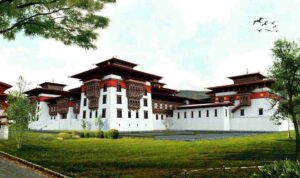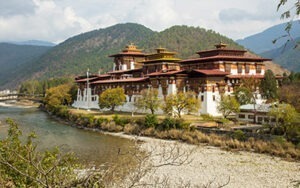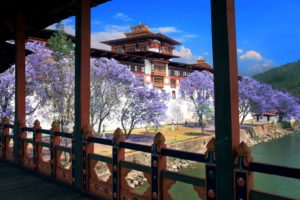Cultural Landmarks and Symbolic Fortresses – The Dzongs of Bhutan
Nestled in the breathtaking landscapes of Bhutan, the Dzongs stand tall as guardians of the country’s rich cultural heritage. These magnificent fortresses, with their unique architecture and symbolic significance, have become iconic cultural landmarks of Bhutan. As a traveler exploring this enchanting land, it is impossible not to be captivated by the grandeur and mystique of the Dzongs. In this article, we will delve into the importance, history, architecture, and cultural significance of the Dzongs, and discover the enduring legacy they hold as guardians of Bhutanese culture.
Importance of the Dzongs as Cultural Landmarks and Symbols of Bhutanese Heritage
The Dzongs of Bhutan hold immense importance as cultural landmarks and symbols of the country’s rich heritage. These fortresses have served as administrative centers, religious institutions, and symbols of power for centuries. They are not merely architectural marvels but also embody the spiritual and cultural essence of Bhutan. The Dzongs serve as a focal point for the community, bringing people together for religious festivals, ceremonies, and other social events. They are a testament to Bhutan’s commitment to preserve its traditions and values in the face of modernization.
History and Architecture of the Dzongs
The history of the Dzongs dates back to the 17th century when they were first built as fortresses to defend against invasions. Over the years, they evolved into architectural masterpieces, blending traditional Bhutanese design with influences from Tibetan and Indian styles. The Dzongs are typically constructed on strategic locations, often perched on hilltops or at the confluence of rivers. They are fortified with thick walls, watchtowers, and intricate woodwork. The most striking feature of Dzong architecture is the utse, a central tower that houses sacred relics and serves as the main religious sanctuary. The intricate carvings, vibrant murals, and colorful prayer flags adorning the Dzongs are a testament to the skilled craftsmanship and artistic traditions of Bhutan.
Prominent Dzongs in Bhutan
Bhutan is home to several prominent Dzongs, each with its own unique history and cultural significance. One such Dzong is the Punakha Dzong, also known as the Palace of Great Happiness. It is considered one of the most beautiful Dzongs in Bhutan and served as the seat of the government until the capital was moved to Thimphu. Another notable Dzong is the Paro Taktsang, also known as the Tiger’s Nest. Perched precariously on a cliff, it is one of Bhutan’s most sacred pilgrimage sites. The Trongsa Dzong, with its strategic location overlooking the Mangdechhu River, is another architectural marvel worth visiting. These Dzongs, along with many others, offer a glimpse into the rich history and cultural heritage of Bhutan.
The Role of the Dzongs as Guardians of Bhutanese Culture and Heritage
The Dzongs play a vital role as guardians of Bhutanese culture and heritage. They serve as religious and educational centers, where monks receive spiritual training and education. The Dzongs also house sacred relics, scriptures, and religious artifacts that are of immense importance to the Bhutanese people. They are the custodians of Bhutan’s unique cultural traditions, preserving the rituals, dances, and ceremonies that have been passed down through generations. The Dzongs act as a living embodiment of Bhutan’s commitment to maintaining its cultural identity amidst the challenges of a rapidly changing world.
Cultural Significance and Rituals Associated with the Dzongs
The Dzongs are deeply intertwined with the cultural fabric of Bhutan. They are the settings for numerous religious festivals, or tshechus, which are celebrated with great pomp and fervor. These festivals bring together the Bhutanese people, who don their finest traditional attire and gather to witness mask dances, traditional music, and other performances. The tshechus are not only a celebration of faith but also an occasion for social bonding and cultural exchange. The Dzongs also host important religious ceremonies, such as the enthronement of the king and the ordination of monks, further cementing their significance in Bhutanese culture.
Exploring the Unique Features of Dzong Architecture
Dzong architecture is characterized by its unique features that set it apart from other architectural styles. The utse, or central tower, is the heart of the Dzong and represents the divine presence. The intricate woodwork and carvings found throughout the Dzongs showcase the skill and craftsmanship of Bhutanese artisans. The vibrant murals depicting religious stories and symbols add a touch of color and spirituality to the Dzongs’ interiors. The courtyards and open spaces within the Dzongs provide a serene and meditative ambiance, inviting visitors to immerse themselves in the spiritual atmosphere. Exploring the unique features of Dzong architecture is a journey into the soul of Bhutanese culture.
Preservation Efforts and Challenges Faced in Maintaining the Dzongs
Preserving the Dzongs is a monumental task that requires careful attention to detail and a deep understanding of their cultural and historical significance. Bhutan has made significant efforts to ensure the conservation and maintenance of these architectural treasures. The Department of Culture and the Royal Society for the Protection of Nature work tirelessly to protect the Dzongs from natural disasters, such as earthquakes and fires, and implement measures to safeguard against the effects of climate change. However, the preservation of the Dzongs faces challenges such as limited resources, urbanization, and the need for sustainable tourism practices. Balancing the need for preservation with the demands of a modern society is an ongoing challenge for Bhutan.
Visiting the Dzongs of Bhutan – Tips for Travelers
Visiting the Dzongs of Bhutan is a truly immersive experience that allows travelers to witness the country’s rich cultural heritage up close. To make the most of your visit, it is advisable to dress modestly and respectfully, as the Dzongs are religious sites. Taking off your shoes before entering the temples and being mindful of photography restrictions are essential to show respect for the religious and cultural traditions. Engaging with local guides and experts can provide invaluable insights into the history and significance of the Dzongs. Remember to plan your visit during one of the tshechus to witness the vibrant festivities and immerse yourself in the Bhutanese way of life.
The Enduring Legacy of the Dzongs in Preserving Bhutan’s Cultural Heritage
As we conclude our exploration of the Dzongs of Bhutan, it becomes evident that these fortresses are not mere architectural wonders but living testaments to Bhutan’s rich cultural heritage. The Dzongs stand as guardians, preserving the traditions, rituals, and values that define the Bhutanese way of life. They are the physical and spiritual embodiment of Bhutan’s commitment to maintaining its unique identity amidst the winds of change. As travelers, we have the privilege to witness and learn from these cultural landmarks, to appreciate the artistry and spirituality they encapsulate. Let us embrace the enduring legacy of the Dzongs and celebrate Bhutan’s remarkable cultural heritage.




